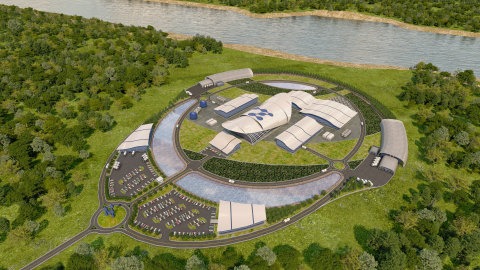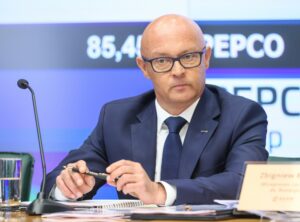„If we add all the capacities of the planned SMRs, we will get a sum exceeding Poland’s demand for power, even if we do not count other sources. So it is clear that they cannot all be built. But which ones will… Here we can refer to the words of Zhou Enlai: it is too early to tell,” says Adam Rajewski specialist from the company Nuclear PL in an interview with BiznesAlert.pl.
Biznesalert.pl: Which of Poland’s SMR projects could be completed?
Adam Rajewski: It is difficult to answer because all the projects are at a very early stage. A number of investors got engaged with technology providers to a lesser or higher degree. Which of the projects have a chance of success depends on how the management boards of the companies concerned will act in the future. I am convinced that some of them will be completed, but today I can only say that not all of the planned projects will happen. This belief is based on simple arithmetic. If we add all the capacities of the planned SMRs, we will get a sum exceeding Poland’s demand for power, even if we do not count other sources. So it is clear that they cannot all be built. But which ones can… Here we can refer to the words of Zhou Enlai: it’s too early to tell.
There are several SMR designs, none have been built yet, none have passed a full certification process in any country. Some have partially closed certain approval processes in the United States. There is a group of technologies, four, five or six that are negotiating for a fairly rapid implementation. In this context, there has been a very interesting decision by the British government last week. A financial support program for the best performing SMR technologies has been developed, and a number of such technologies have been selected that roughly coincide with those that Polish investors plan to build in Poland. Now these companies will be invited by the British to apply for state support, after their consideration, next summer the government will provide such assistance. It is interesting to see how the British define the most promising technologies. In their understanding, those are solutions in which the decision to build can be made by 2029 and the projects can be launched in the mid-30s. In Poland, the announcements are a bit more ambitious. I think the British are more realistic.
In Poland, SMRs, based on larger technologies, seem to make more sense in the Polish energy system. We also have some crazy ideas for small reactors, like 20 MW installations, but they probably won’t be built. In fact, reportedly, the Internal Security Agency has already issued negative opinions about them. But the programs of the biggest players like Orlen Synthos, KGHM or Industria, which wants to invest in the Rolls-Royce design, have the best chance of implementation. We will see how they fit into energy policy, into strategic planning.
Each of these projects considered separately I think makes sense. Whether in these locations is a separate issue, but the idea that in Poland we will build such investments holds water.
How will they fit into Poland’s energy policy?
First of all, as I said, when we add all these plans together, we get, in terms of capacity, an absurd number. It is neither physically possible to build it in a meaningful time horizon, nor does it need to be. Secondly, we have an energy policy that does not take these investments into account. We are in this strange situation where almost all investments in SMRs have a serious shareholder in the form of a state treasury company. On the other hand, we do not have this in the energy policy. Let me remind you that today, Polish Energy Policy provides only for nuclear power plants built by Polish Nuclear Power Plants (PEJ). And we already have a second big project, which also does not exist in this policy.
Is there room for SMRs next to a large nuclear power plant and RES?
I’m not a fan of the SMR label, because it only makes the discussion more difficult. Many pages say that SMRs should have a capacity of up to 300 MW, but on the other hand Rolls-Royce says their reactor is an SMR, but it’s to have 470 MW. A large part of these technologies, apart for the smallest ones, are simply relatively small nuclear blocks that do not differ much from the „big”ones. It should be remembered that these are not „small power plants”, 300-400 MW is the equivalent of the Bełchatów coal-fired power plant. This is why I believe we should not think in opposites about this – large power plants vs. SMRs. They only differ in the scale of investment. There are also gas-fired power plants with different capacities, such as the one in Rybnik, which is supposed to have a capacity of almost 900 MW, and there are also facilities with a hundred and dozens of MW each. And there is room in the energy policy for both types of investments. It is important that this is coordinated.
I am concerned that such an uncoordinated competition between investors will mean these projects will interfere with each other. In Poland, we do not yet have a nuclear power plant, we have one process that is quite advanced, although this may not be in line with popular opinion. The fact that the PEJ investment has an environmental decision indicates that many years of work have already been done. Maybe it didn’t have to last that long, but it’s not something that could happen quickly. It had to take a few years. But construction still hasn’t started. Therefore, colloquially speaking, the Polish market wants to suck in all of the specialists, but there aren’t many. This will also hamper nuclear projects conducted abroad, such as those in Sweden or the Czech Republic. We in Poland have several investors who are starting to buy specialists, on the market you can already see that some companies are stealing people from others. The problem does not end with personnel, soon there will be competition for specialized resources or entities conducting specialized research, such as the development of Polish-language documentation. SMR designs are developed abroad, in a different regulatory order. There is really a lot of technical, specialized work here, and it may turn out that these projects steal people or resources from each other. Moreover, the same can happen at the level of state administration, for example, several applications for an environmental decision will be submitted at the same time, the Director General of Environmental Protection, or rather the Directorate working with him, will have to simultaneously consider a very large amount of documentation. You can’t expect, or at least I don’t expect, four times as many people to be involved all of a sudden, because four entities have made such requests. A similar problem may arise in the State Atomic Energy Agency (PAA), especially if further down the design path it becomes necessary to issue more „advanced” permits by the president of the PAA. Then it may turn out that these projects undermine each other. Perhaps it would be useful to coordinate them at the state level. One can take advantage of the fact, which in my opinion is positive, that in each of these projects some company of the state treasury is involved, and arrange these projects better, like the Brits do. Instead of every investor competing for technology and locations.
If the Civic Coalition, the Left and the Third Way form a coalition government, will SMRs become part of the Polish energy sector?
As far as we know from publicly available information, we do not have any strong anti-nuclear voices. I do not expect a change of direction in the use of nuclear energy. As for the SMRs themselves, this is too hot of a topic, also on the international market, to simply disappear. Investing in only one technology, as it was planned and is written in the „Polish Nuclear Energy Program”, is a risk. The French have recently found out what happens when you have too many similar installations in your energy system and suddenly a systemic problem is detected. Some diversification of technology certainly makes sense. It is an open question whether it should be two full-scale technologies, a one large-scale technology with SMRs or a third solution.
It should also be remembered that serious state and private actors are involved in these projects. Therefore, a possible departure from these projects would not be so easy. There was a lot of money involved, maybe not as much as the entire cost of construction but nevertheless. I believe that these processes aimed at investing in SMRs will continue. Whether or not they will be completed, time will tell. It is too early to determine that.
An important issue is the financing of these investments, without the involvement of the state it can be difficult. However, without a friendly approach from the state, these projects will not happen. But it’s all going to come together in the next couple of years.
Compiled by Marcin Karwowski









